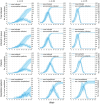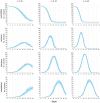A theoretical epidemiological investigation into the transmission of respiratory infectious diseases during group meals among military personnel based on an individual-based model
- PMID: 40469601
- PMCID: PMC12133872
- DOI: 10.3389/fpubh.2025.1545938
A theoretical epidemiological investigation into the transmission of respiratory infectious diseases during group meals among military personnel based on an individual-based model
Abstract
Introduction: Within military settings, soldiers are arranged to eat together in a self-service manner for every meal. The process of food selection and consumption often leads to close contact amongst individuals, heightening the risk of respiratory infectious disease transmission. To comprehend the transmission dynamics during communal dining, we have conducted an in-depth epidemiological investigation.
Methods: The dining process was divided into two phases: lining up for food and dining at designated seats. Soldiers were randomly split into two queues and entered the food selection area from the same side. The movements of the soldiers dynamically altered both the queues and the contact duration and distance between susceptible individuals and infection sources. We utilized a random computer model using MATLAB software, with the individual as the unit of study, for simulating the food selection process. This model quantitatively analyzed the dynamic process of disease transmission within the queues due to the dispersion of small pathogen-carrying particles.
Results: Our findings indicate that close interactions between individuals during picking up food can result in the persistent transmission of airborne infectious diseases. Implementing measures such as discontinuing buffet-style meals, implementing staggered dining schedules, and mandating mask-wearing during food collection could help control disease transmission during an epidemic.
Discussion: This study demonstrates that the individual-based model can simulate the dynamic process of disease transmission through complex behavioral activities and is more suitable for conducting research on the dynamics of infectious diseases in small-scale populations. Since this is a simulation conducted in a virtual scenario, the results of the model still need to be verified through field investigations. Nevertheless, once robust outbreak investigation studies have yielded reliable model parameters, these parameters can be adapted to this and other similar situations to demonstrate the potential for transmission.
Keywords: buffet; individual-based model; military; queues; respiratory infectious diseases.
Copyright © 2025 Guo, Liu, Jiang, Yu, Xiao, Wang, Cui, Li, Yang, Tian and Wang.
Conflict of interest statement
The authors declare that the research was conducted in the absence of any commercial or financial relationships that could be construed as a potential conflict of interest.
Figures






Similar articles
-
An artificially simulated outbreak of a respiratory infectious disease.BMC Public Health. 2020 Jan 30;20(1):135. doi: 10.1186/s12889-020-8243-6. BMC Public Health. 2020. PMID: 32000737 Free PMC article.
-
Folic acid supplementation and malaria susceptibility and severity among people taking antifolate antimalarial drugs in endemic areas.Cochrane Database Syst Rev. 2022 Feb 1;2(2022):CD014217. doi: 10.1002/14651858.CD014217. Cochrane Database Syst Rev. 2022. PMID: 36321557 Free PMC article.
-
Impact of Acute Respiratory Infections on Medical Absenteeism Among Military Personnel: Retrospective Cohort Study.JMIR Form Res. 2025 Apr 18;9:e69113. doi: 10.2196/69113. JMIR Form Res. 2025. PMID: 40249956 Free PMC article.
-
Simulating near-field enhancement in transmission of airborne viruses with a quadrature-based model.Indoor Air. 2021 Nov;31(6):1843-1859. doi: 10.1111/ina.12900. Epub 2021 Jul 23. Indoor Air. 2021. PMID: 34297863 Free PMC article.
-
Review and comparison between the Wells-Riley and dose-response approaches to risk assessment of infectious respiratory diseases.Indoor Air. 2010 Feb;20(1):2-16. doi: 10.1111/j.1600-0668.2009.00621.x. Epub 2009 Jul 31. Indoor Air. 2010. PMID: 19874402 Free PMC article. Review.
References
MeSH terms
LinkOut - more resources
Full Text Sources
Medical

